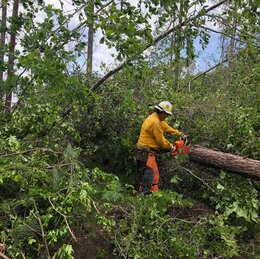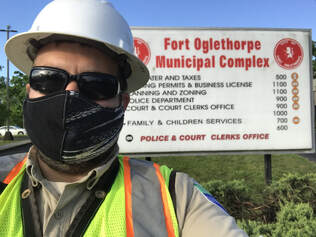How the agency known for sustaining forests has responded to the challenges of a global pandemic
When it became clear that Georgia was not immune to the COVID-19 pandemic, we made a conscious decision to be proactive in adjusting our operations in response. We implemented a teleworking protocol immediately, in an attempt to protect our employees, their families and their communities. At the same time, we retained a keen focus on our mission of service to Georgia and her forest landowners. Additionally, we assumed our role of advanced logistical support to the state in times of crisis. This time, it was not clearing hurricane devastation, but rather staffing a Public Health distribution facility near Atlanta. This work continues at the time of this writing.
As this issue goes to press, state government has been tasked with finding historic budget savings by Governor Brian Kemp. I’m proud of how the GFC team is responding to this challenge; the mountain is tall, but we’ve already started our climb. We ask for your continued support and prayers as our state and our agency faces these unprecedented challenges.
— Chuck Williams, Director, Georgia Forestry Commission
As this issue goes to press, state government has been tasked with finding historic budget savings by Governor Brian Kemp. I’m proud of how the GFC team is responding to this challenge; the mountain is tall, but we’ve already started our climb. We ask for your continued support and prayers as our state and our agency faces these unprecedented challenges.
— Chuck Williams, Director, Georgia Forestry Commission
Emergency Response
 GFC transported medical supplies to distribution points throughout the state.
GFC transported medical supplies to distribution points throughout the state.
When emergencies such as hurricanes, tornadoes and pandemics strike Georgia, the Georgia Emergency Management Agency (GEMA) calls on special teams from the Georgia Forestry Commission (GFC) to support statewide response operations. Chain-saw strike teams attack downed trees to clear vital thoroughfares following hurricanes and tornadoes. Others manage logistics for multiple agencies responding to those same weather events—or other emergencies, such as the fight against a pandemic.
The GFC is known as the go-to agency for hit-the-ground-running incident response, because of its employees who have extensive experience on “Incident Management Teams” (IMT). The teams function under the Incident Command System (ICS), which was developed to unify resources from different agencies under a common command structure. ICS is used in every manner of emergency, facilitating coordination between all responders, including all levels of government, with public, private and non-governmental organizations.
On March 10, the Georgia Department of Public Health (DPH) activated Georgia’s COVID-19 response by establishing a central warehouse to receive and distribute critical equipment to public healthcare facilities and EMS’s across five zones statewide. In addition to GEMA, DPH and GFC, a number of agencies have participated in the effort, including the Georgia State Patrol, Department of Natural Resources, Georgia Department of Transportation, Georgia National Guard and local law enforcement.
It is often said the Incident Management System “brings order out of chaos,” which adequately describes the Herculean effort that has allowed Georgia to stand strong against a powerful new enemy. On March 13, GFC’s IMT joined the effort. With experienced GFC personnel staffing leadership roles in Command, Planning, Logistics and Operations, systems were founded to manage every aspect of the flow of materials and information that truly has had life-and-death importance: coronavirus test kits, ventilators, surgical masks, hand sanitizer, face shields, even body bags—in sizes “adult” and “pediatric.” This warehouse has kept the lifeblood for saving lives flowing strongly.
As sheltering in place, social distancing and scrupulous hygiene became the norm, GFC IMT personnel logged week after week of service. An average 60 GFC people are serving every week. Twenty GFC people per day on average are working in the warehouse. The enormity and pace of the mission cannot be overstated. GFC’s emergency responders say it’s their job, and they’re proud to be serving their fellow Georgians.
Tornadoes
Between the night of April 12 and the morning of April 13, 30 tornadoes touched down across Georgia. They ranged from level EF0 to EF3, and from a half mile to 17 miles long. The storms affected rural, urban and suburban areas. GFC chain- saw crews were instrumental in clearing damage from roadways and public property. An Urban Forest Strike Team from GFC’s Sustainable Community Forestry Program conducted field assessments along seven storm tracks. Altogether, the storms produced $3,692,960 in timber damage across 5,218 acres in 31 counties. Community forests near the cities of Fort Oglethorpe and Odum sustained damage to approximately 100 trees on four city-owned properties, including two public parks. https://gatrees.org/wp-content/ uploads/2020/05/Timber-Impact-As- sessment-April-2020.pdf.
Forest Management
 Community Forester Seth Hawkins assesses tornado damage, safely.
Community Forester Seth Hawkins assesses tornado damage, safely.
Forest Management staff and technicians have accomplished a tremendous amounf work during these challenging times. Most everyone’s homes have become their offices, social distancing is the norm and hand sanitizer is now a partner with tick spray. A great amount of effort by the Management Department, as well as Geographic Information System (GIS) staff, went into producing the April Tornadoes Assessment. In addition, cost-share practices have been planned and certified, logging sites and case management have been monitored, harvesting advice has been given, pine-bark-beetle prediction trapping was completed, urban communities are being helped in new ways, etc. At press time in early May, our team had completed 1,507 management cases since March; down some from previous years but very encouraging to see in light of the COVID-19 situation. The Farm Recovery Block Grant sign-up ended on April 30. The block grant team is finishing its reviews of applications and final numbers will be released soon.
Forest Services, Utilization & Marketing
Despite new challenges created by COVID-19, these staff members have continued to serve Georgia citizens, timber owners and the forest industry. From positions across the state, the team has continued working with partner agencies, answering customer requests and man- aging grants that add value to the state economy throughout the forest products supply chain. Data is always being gathered for a number of productivity reports, including the annual Timber Product Output Survey. The team continues to track the capabilities of mills, processing plants and transportation systems.
Adhering to social distancing guide- lines has created the need for one-person teams (instead of the usual pairs) to conduct Forest Inventory Analysis work, the process of measuring and documenting timber conditions on forested plots throughout the state. The information is critical to the marketing of Georgia’s forest industry capabilities to the world. Read the recently completed Forests of Georgia 2018 fact sheet at: https://gatrees.org/wp-content/ uploads/2020/04/Forests-of-Georgia- 2018.pdf.
Adhering to social distancing guide- lines has created the need for one-person teams (instead of the usual pairs) to conduct Forest Inventory Analysis work, the process of measuring and documenting timber conditions on forested plots throughout the state. The information is critical to the marketing of Georgia’s forest industry capabilities to the world. Read the recently completed Forests of Georgia 2018 fact sheet at: https://gatrees.org/wp-content/ uploads/2020/04/Forests-of-Georgia- 2018.pdf.
Law Enforcement
Like other departments, GFC’s Law Enforcement (LE) team has adjusted to health guidelines by teleworking. Investigations have continued, with limited in-person meetings. In the first two weeks of April, seven timber complaint investigations were opened—a number that is slightly above the monthly average. An online database is now being utilized to track timber transaction complaints. When entered by GFC personnel, an automatic alert is sent to LE, which streamlines the process for the complainant.
Forest Protection

The GFC Protection Department has remained on call and responsive to wildfire, 24/7, in all 159 counties. Wildland fire personnel and equipment are strategically positioned at 119 locations throughout the state.
Fortunately, wildfire activity has been low throughout the spring. From January through April 24, 606 wildfires have burned 2,579 acres in Georgia. The five-year average for the same period is 1,549 wildfires. No significant wildfire activity is expected for the Southeast for the next several months.
Rainfall through- out the year has helped alleviate high fire danger for the most part, other than on days when winds are brisk or gusty and relative humidity is low. The Keetch-Byram Drought Index indicates good soil moisture in most parts of the state.
The Environmental Protection Division’s annual ban on outdoor burning began on May 1 in 47 counties, mostly in the northern half of the state. For seven counties that are normally included in the summer burn ban, restrictions were activated on June 1, giving them extra time to clear vegetative debris from April storms. Those counties are Banks, Catoosa, Chattooga, Floyd, Gordon, Upson and Walker. The burning restrictions are put in place during the summer months, when increases in ground-level ozone may create health risks.
Elsewhere, Georgians are required to get a burn permit from the GFC before burning outdoors. Permits are available online at GATrees.org, by calling 1-877-OK2- BURN or by contacting your county GFC office. The GFC is particularly mindful about the potential impact of smoke and reminds everyone who burns to also be aware of their smoke and where it is going. Air quality indices are closely monitored by the Environmental Protection Division and GFC wherever prescribed fire is permitted.
Fortunately, wildfire activity has been low throughout the spring. From January through April 24, 606 wildfires have burned 2,579 acres in Georgia. The five-year average for the same period is 1,549 wildfires. No significant wildfire activity is expected for the Southeast for the next several months.
Rainfall through- out the year has helped alleviate high fire danger for the most part, other than on days when winds are brisk or gusty and relative humidity is low. The Keetch-Byram Drought Index indicates good soil moisture in most parts of the state.
The Environmental Protection Division’s annual ban on outdoor burning began on May 1 in 47 counties, mostly in the northern half of the state. For seven counties that are normally included in the summer burn ban, restrictions were activated on June 1, giving them extra time to clear vegetative debris from April storms. Those counties are Banks, Catoosa, Chattooga, Floyd, Gordon, Upson and Walker. The burning restrictions are put in place during the summer months, when increases in ground-level ozone may create health risks.
Elsewhere, Georgians are required to get a burn permit from the GFC before burning outdoors. Permits are available online at GATrees.org, by calling 1-877-OK2- BURN or by contacting your county GFC office. The GFC is particularly mindful about the potential impact of smoke and reminds everyone who burns to also be aware of their smoke and where it is going. Air quality indices are closely monitored by the Environmental Protection Division and GFC wherever prescribed fire is permitted.
Reforestation
The department responsible for collecting seeds and planting, nurturing, lifting and selling a wide variety of soft and hardwoods has been keeping a brisk pace throughout the ongoing COVID- 19 emergency. Fortunately, as the health restrictions were being imposed, GFC Reforestation was coming out of its shipping season and beginning its seed- sowing season. Staff has teleworked when feasible, with one person staffing the nursery phone and another at the seed extractory, stratifying customer seeds and performing other needed tasks.
A great deal of field work commenced, including tractor operations that got the fields turned and bottoms plowed. Reforestation staff stepped up to the plate in a big way when planned assistance from inmate details was cancelled. Employees took on the task of laying a large amount of pipe, keeping social distancing protocols in place. Days of irrigation repair were performed, along with laying above- ground irrigation, installing sprinkler heads, applying pre-plant fertilizer and sowing seed for the hardwood and long- leaf, loblolly and slash pine crops.
All planting activities were time sensitive and had to be completed by early May. Currently, the seedlings that are up look very healthy and it appears this will be a good growing season. Tree improvement work is in progress, including installing and measuring genetic trials.
A great deal of field work commenced, including tractor operations that got the fields turned and bottoms plowed. Reforestation staff stepped up to the plate in a big way when planned assistance from inmate details was cancelled. Employees took on the task of laying a large amount of pipe, keeping social distancing protocols in place. Days of irrigation repair were performed, along with laying above- ground irrigation, installing sprinkler heads, applying pre-plant fertilizer and sowing seed for the hardwood and long- leaf, loblolly and slash pine crops.
All planting activities were time sensitive and had to be completed by early May. Currently, the seedlings that are up look very healthy and it appears this will be a good growing season. Tree improvement work is in progress, including installing and measuring genetic trials.
State Lands
Timber sales activity continues as several sister agencies, including the Georgia Department of Natural Resources and
the University of Georgia, seek to harvest some of their lands. The GFC has also been busy assisting the U.S. Forest Service in sales preparations for additional harvests under the Good Neighbor Agreement (GNA) on the Oconee and Chattahoochee National Forests. Under the GNA, the GFC performs critical management work on federal lands to keep the nation’s forests healthy and productive. Technology is helping us continue our work by utilizing drones to evaluate timber stands. We’re using them for several ongoing projects, including looking for beetle activity, monitoring harvests, evaluating timber damage due to recent storms, and assessing the completion percentage of an ongoing harvest. This technology allows us to be more efficient and accurate in our timberland work and we plan to use it in the future to monitor conservation easements and help private landowners get a bird’s-eye view of their property.
the University of Georgia, seek to harvest some of their lands. The GFC has also been busy assisting the U.S. Forest Service in sales preparations for additional harvests under the Good Neighbor Agreement (GNA) on the Oconee and Chattahoochee National Forests. Under the GNA, the GFC performs critical management work on federal lands to keep the nation’s forests healthy and productive. Technology is helping us continue our work by utilizing drones to evaluate timber stands. We’re using them for several ongoing projects, including looking for beetle activity, monitoring harvests, evaluating timber damage due to recent storms, and assessing the completion percentage of an ongoing harvest. This technology allows us to be more efficient and accurate in our timberland work and we plan to use it in the future to monitor conservation easements and help private landowners get a bird’s-eye view of their property.
Stasia Kelly is a media relations specialist with Georgia Forestry Commission. Stasia is focused on telling the story of forestry and the immense impact of the industry on Georgia’s environment, economy and heritage.
|
Georgia Forestry Magazine is published by HL Strategy, an integrated marketing and communications firm focused on our nation's biggest challenges and opportunities. Learn more at hlstrategy.com
|

